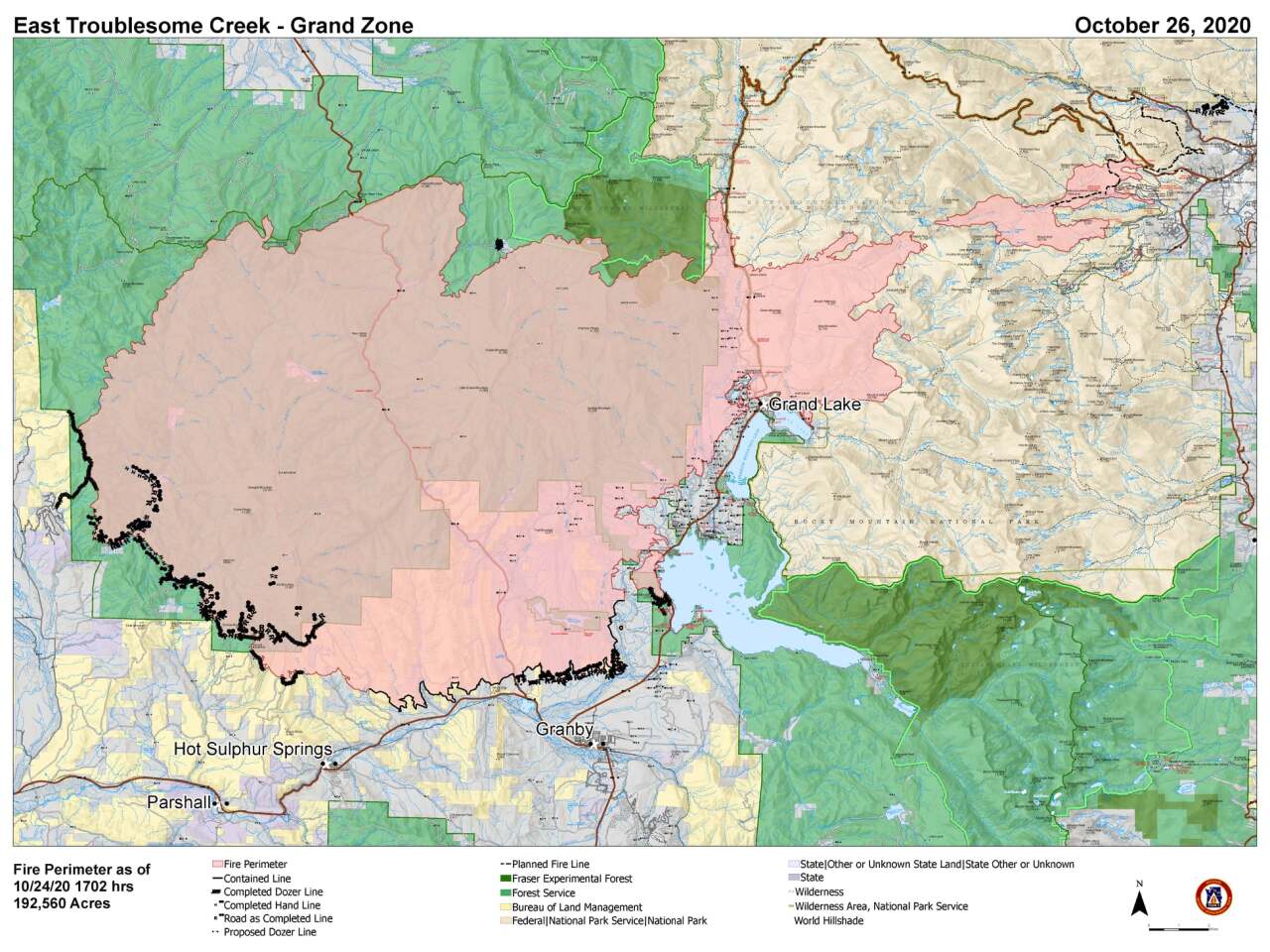GRAND COUNTY, Colo. — The East Troublesome Fire area saw six to 12 inches of snow since Sunday and fire officials said it will help halt fire growth for the next few days.
“A very good dump of snow for us and very welcome in terms of support to the work we're doing and to getting these fires to stopped, so we’re really tickled to see that,” Pacific Northwest Team 3 Incident Commander Noel Livingston said.
Livingston said it started raining on the fire around 11 a.m. Sunday, which quickly switched to snow. Once snow started, they saw no fire activity throughout the day and overnight. While the snow is welcomed, Livingston said it also creates challenges. They had to pull most of their crews out once accumulation began and road conditions worsened Sunday.
They saw very little change to the footprint of the fire as a result of the conditions. Containment increased to 15% and the fire didn't see growth overnight, remaining at 192,560 acres.

Livingston made clear the snow would not put the East Troublesome Fire out completely. Their primary focus over the next few days would be getting people back inside their homes. Crews will take advantage of the pause in fire activity to repair and refresh equipment to be ready for when the weather clears. Throughout the day, fire officials will continue to assess conditions for opportunities for firefighters to engage on the fireline and assist local agencies.
The Grand County Sheriff's Office on Monday afternoon announced a re-entry plan for residents on the east side of Highway 34.
At 2 p.m., authorities planned to open all areas south of Highway 34 and County Road 6 east and west on both sides of the highway, including all areas of County Road 6. County Road 40 would remain closed.
At 4 p.m., authorities planned give residents access to areas on the east side of Highway 34 north into Grand Lake, just north of the Gateway Inn. Areas to the west of Highway 34 will remained closed as crews continue their work.
A re-entry plan for areas west of 34 will require more extensive preparation, disaster assessment and safety management. East of 34, electricity and gas service were available. Sewer service was available for Three Lakes Sanitation. Residents should check with their local provider about water service.
The conditions also led to several changes in evacuations in the area. The following evacuations were downgraded from mandatory to voluntary:
- Estes Valley east of the Marys Lake Road corridor, east of the Elm Road corridor and east of the Fall River Road corridor
- Highway 7 to Allenspark
- East side of Highway 7 east to Panorama Peak
- Highway 34 from Mall Road to Drake
Some evacuations were lifted entirely:
- All areas south of Highway 40
- The Town of Granby
- The Town of Hot Sulphur Springs
- South end of County Road 21
- All areas south of Granby through Tabernash
- Meeker Park and Wild Basin area in Boulder County
You can see all of the current evacuations still in place here. People living in the Estes Park area were being allowed back in Sunday for the purpose of winterizing their homes. Grand County Sheriff Brett Schroetlin said Sunday that homes have been lost in the fire, but he was not prepared to release the preliminary numbers. Livingston said Monday assessment teams are out in full force and working as quickly as possible.
The town of Estes Park said that community members will have access to the area but that others would be restricted mostly because of ongoing evacuation orders and firefighting efforts in the area. Rocky Mountain National Park and National Forests in the area remain closed.
“We look forward to the time we can lift evacuation orders for our community and begin to welcome guests back to our valley,” the town said. “Residents, local business employees, and service providers should be able to access Estes Park via state highways.”
“We recommend having some material that indicates your residence or employment in the valley available as you travel into Estes Park,” the town added.
This comes after several days of aggressive fire weather. The fire exploded from Wednesday to Thursday, growing by roughly 150,000 over the course of a day.
The cause of the fire remains under investigation. It began Oct. 14 north of Hot Sulphur Springs. The estimated total containment date is Nov. 10. It is the second largest wildfire in Colorado's recorded history.
The state's 10 largest wildfires in history, ranked by acreage, are:
1. Cameron Peak Fire (2020): 208,663 acres
2. East Troublesome Fire (2020): 192,560 acres
3. Pine Gulch Fire (2020): 139,007 acres
4. Hayman Fire (2002): 137,760 acres
5. Spring Fire (2018): 108,045 acres
6. High Park Fire (2012): 87,284 acres
7. Missionary Ridge Fire (2002): 72,962 acres
8. 416 Fire (2018): 54,000 acres
9. Bridger Fire (2008): 45,800 acres
10. Last Chance Fire (2012): 45,000 acres
Note: The Rocky Mountain Area Coordination Center said the West Fork Complex fire, which burned a total of 109,632 acres in 2013, is not included on this list since it involved three separate fires.
Denver7 Gives has started a new fundraising campaign for victims of Colorado's wildfires with all proceeds staying to help our local neighbors. See how you can donate here.




